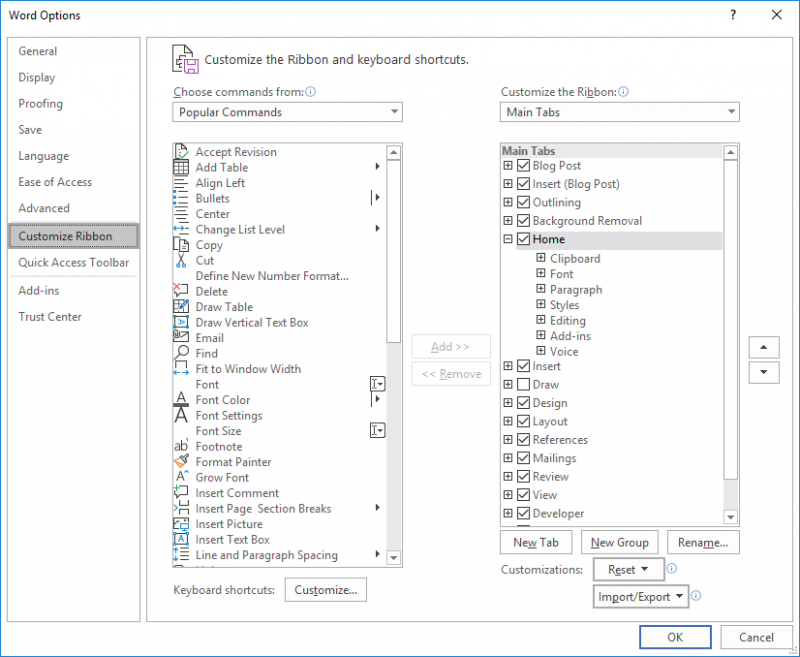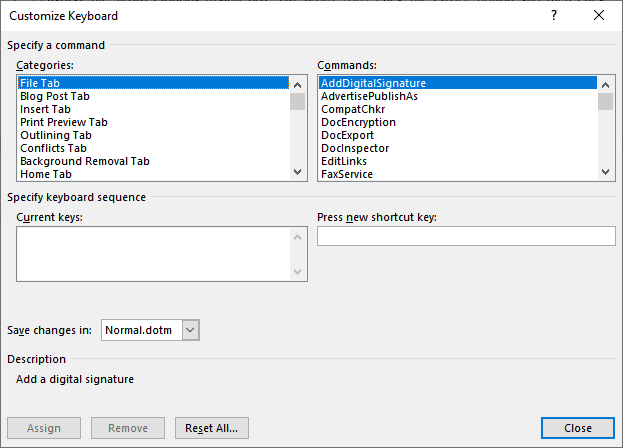Please Note: This article is written for users of the following Microsoft Word versions: 2007, 2010, 2013, 2016, 2019, 2021, and Word in Microsoft 365. If you are using an earlier version (Word 2003 or earlier), this tip may not work for you. For a version of this tip written specifically for earlier versions of Word, click here: Restoring a Keyboard Shortcut.
Written by Allen Wyatt (last updated May 7, 2022)
This tip applies to Word 2007, 2010, 2013, 2016, 2019, 2021, and Word in Microsoft 365
Word makes it easy to assign keyboard shortcuts to a variety of purposes. The two most common things assigned to shortcut keys are macros and built-in Word commands. It is possible, however, to assign a keyboard shortcut to an item and then later regret the assignment. For instance, you might assign a macro to the shortcut Ctrl+~ (the tilde symbol). However, this is a built-in shortcut for typing a letter with a tilde on top, most often used in foreign languages. Of course, if you later discover you need the built-in shortcut, you may wonder how to restore the keyboard shortcut to its intended purpose, rather than running the macro.
This is a relatively easy task. Basically, you need to follow the same steps you followed in order to assign the macro to the shortcut, with one important change. Here's what to do:

Figure 1. The Customize Ribbon options of the Word Options dialog box.

Figure 2. The Customize Keyboard dialog box.
The shortcut should now be removed from the macro and it (the shortcut) again resumes doing its previous duty.
Note:
WordTips is your source for cost-effective Microsoft Word training. (Microsoft Word is the most popular word processing software in the world.) This tip (10476) applies to Microsoft Word 2007, 2010, 2013, 2016, 2019, 2021, and Word in Microsoft 365. You can find a version of this tip for the older menu interface of Word here: Restoring a Keyboard Shortcut.

Create Custom Apps with VBA! Discover how to extend the capabilities of Office 365 applications with VBA programming. Written in clear terms and understandable language, the book includes systematic tutorials and contains both intermediate and advanced content for experienced VB developers. Designed to be comprehensive, the book addresses not just one Office application, but the entire Office suite. Check out Mastering VBA for Microsoft Office 365 today!
Need to get rid of a keyboard shortcut key you previously defined? It's easy to do if you follow these steps.
Discover MoreWant to assign some fancy characters to keyboard keys for characters you seldom use? There are a couple of ways you can ...
Discover MoreMost of the time you'll use regular spaces between words in a document, but there may be times you want to use a special ...
Discover MoreFREE SERVICE: Get tips like this every week in WordTips, a free productivity newsletter. Enter your address and click "Subscribe."
There are currently no comments for this tip. (Be the first to leave your comment—just use the simple form above!)
Got a version of Word that uses the ribbon interface (Word 2007 or later)? This site is for you! If you use an earlier version of Word, visit our WordTips site focusing on the menu interface.
Visit the WordTips channel on YouTube
FREE SERVICE: Get tips like this every week in WordTips, a free productivity newsletter. Enter your address and click "Subscribe."
Copyright © 2025 Sharon Parq Associates, Inc.
Comments